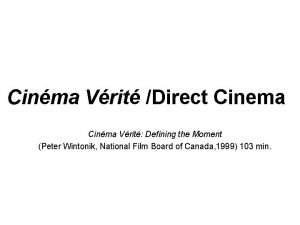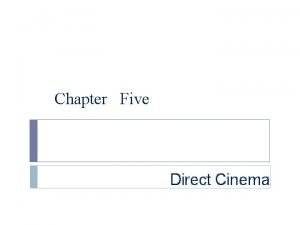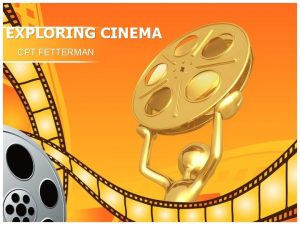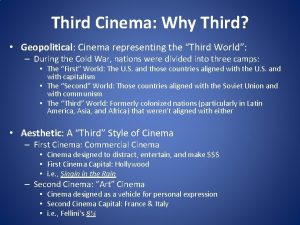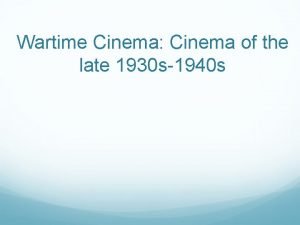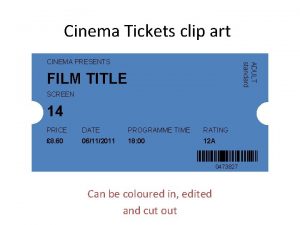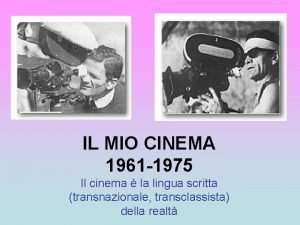AFRICAN CINEMA A Primer AFRICAN CINEMA The real

















- Slides: 17

AFRICAN CINEMA A Primer

AFRICAN CINEMA The real background for African cinema as influenced by Europeans was the imperialistic “Scramble of Africa” in 1884; at a meeting in Berlin, European nations met to carve up the continent of Africa (they had a “duty” to civilize Africans):



AFRICAN CINEMA Commercial vs. “Parallel” African Cinema (borrowing the term “parallel” from Indian cinema; “parallel” = art or other non-commercial film)

AFRICAN CINEMA “Parallel” African Cinema, Anglophone: Colonial Office of the British Film Institute created the Bantu Educational Cinema Experiment in present-day Tanzania in 1935, with a goal of educating Africans (e. g. , Post Office, Savings Bank); ended in 1937 British set up the Colonial Film Unit in 1939 with branches across Anglophone Africa; the immediate goal was to encourage African participation in WWII, according to Jean Rouch Spurred by a report to UNESCO by John Grierson, the CFU established a film school in Gold Coast (Ghana) in 1949 CFU involvement in Africa ended around 1955, as British African colonies achieved independence Nigeria’s film industry was an indirect offshoot of this (e. g. , the CFU left behind 16 mm film equipment)

AFRICAN CINEMA Commercial African Cinema, Anglophone (“Nollywood”!) Nigerian commercial film industry Mostly Anglophone, with some indigenous languages used By far the biggest African film industry; Second-largest film industry in the world, after India, in terms of number of feature released (~200 per month) Shot on video (at first, tape. . . now, direct to drives) Distributed on video—no theatrical release, direct to home on disc Films are shot quickly and cheaply Content emphasizes supposedly “authentic” Nigerian issues, including the intersection of indigenous cultural heritage elements such as witchcraft (juju) or voodoo, and religion (Christianity and/or Islam) See the documentaries Welcome to Nollywood (2007) and Nollywood Babylon (2008)

AFRICAN CINEMA “Parallel” African Cinema, Francophone: The Laval Decree of 1934 limited African involvement in films made by the French in Africa (to limit subversive content) In the 1950’s, documentarist Jean Rouche’s work in Niger and Ivory Coast demystified film for Africans Filmmaking was subsequently fostered by the French, via the French Ministry of Cooperation (the cinema division was headed by Jean. Rene Debrix, who described himself as a student of Abel Gance); the Cooperation operated either as front-end producer, or as postproduction distributor (e. g. , Sembene’s La Noire de. . . ) of African films The Cooperation is viewed as a “neo-colonialist tool” by some historians Through the 1970 s, 80% of African films were Francophone

“PARALLEL” AFRICAN CINEMA Three Francophone nations will be examined: Senegal National monetary support, but no national cinema production facilities Mali In 1961, the government set up a Centre Malien de Cinema for the “political education of the citizen and the worker”; Joris Ivens was invited to make an educational film Burkina Faso Substantial government support. . . a national cinema. . . with private film companies springing up in the late 1990 s


SENEGAL Ousmane Sembene (1923 -2007) “The Father of African Film” Key films: La Noire de. . . (Black Girl) (1966) (no subtitles) Turned down for pre-funding by the French Cooperation because of its pseudo-slavery theme Faat Kiné (2000) (trailer, sort of) Looks at the place of women in post-colonial Senegal Moolaadé (2004) (trailer) Focus on female genital mutilation

SENEGAL Djibril Diop Mambéty (1945 -1998) Worked experimentally, with non-linear narratives Key films: Touki Bouki (1973) (trailer) A cowherd with a motorcycle and a student attempt to go to Paris; extremely French New Wave-y Hyènes (1992) (trailer) An adaptation of Swiss playwright Friedrich Dürrenmatt’s The Visit

MALI Manthia Diawara (1953 - ) Scholar and filmmaker, professor at NYU BOOK: African Cinema: Politics and Culture (1992) FILM: Sembene: The Making of African Cinema (1994)

MALI Souleymane Cissé (1940 - ) Yeelen (1987)—(4 min. beginning…Warning!! Animal harmed. ) A 13 th-century tale based on a Bambara legend, an heroic quest

BURKINA FASO Idrissa Ouedraogo (1954 - ) Tilai (The Law) (1990) (trailer) Intense tale of family conflict Lumiere & Company (segment) (1995)

BURKINA FASO Gaston Kabore (1951 - ) Zan Boko (1988) (subtitled)—Full film only…see beginning, and 5: 15 in, part 3 The story of a simple farmer who resists, and then must deal with, encroaching urbanization Lumiere & Company (segment) (1995)

END
 La vrit
La vrit African american cinema history
African american cinema history Rt pcr primer design
Rt pcr primer design Mật thư tọa độ 5x5
Mật thư tọa độ 5x5 Từ ngữ thể hiện lòng nhân hậu
Từ ngữ thể hiện lòng nhân hậu Trời xanh đây là của chúng ta thể thơ
Trời xanh đây là của chúng ta thể thơ Tư thế ngồi viết
Tư thế ngồi viết V cc
V cc Gấu đi như thế nào
Gấu đi như thế nào Thơ thất ngôn tứ tuyệt đường luật
Thơ thất ngôn tứ tuyệt đường luật Hổ đẻ mỗi lứa mấy con
Hổ đẻ mỗi lứa mấy con Thế nào là hệ số cao nhất
Thế nào là hệ số cao nhất Diễn thế sinh thái là
Diễn thế sinh thái là Frameset trong html5
Frameset trong html5 Vẽ hình chiếu vuông góc của vật thể sau
Vẽ hình chiếu vuông góc của vật thể sau 101012 bằng
101012 bằng Thế nào là mạng điện lắp đặt kiểu nổi
Thế nào là mạng điện lắp đặt kiểu nổi Lời thề hippocrates
Lời thề hippocrates
